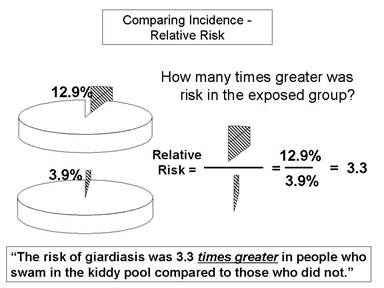RCTs > Relative Risk and Absolute Risk
Contents:
Need help with a homework problem? Check out our tutoring page!
1. What is Relative Risk?
The relative risk (also called the risk ratio) of something happening is where you compare the odds for two groups against each other.
For example, you could have two groups of women: one group has a mother, sister or daughter who has had breast cancer. The other group does not have any close female relatives who have had the disease. The group with close family members who have had the disease are more likely to develop breast cancer (National Cancer Institute). Relative risk is usually reported as a percentage (i.e. 10% more likely) but you’ll also see it written as “x times more likely” (i.e. ten times more likely).
Although relative risk does provide some information about risk, it doesn’t say anything about the actual odds of something happening; on the other hand, absolute risk does.

Relative Risk / Risk Ratio Examples
With this in mind, ket’s say the absolute risk of a non-smoker getting breast cancer over a lifetime is 10%. Then say, smokers have an increased risk of 30%. That 30% refers to the 10%, or 10/100. The relative risk increase of getting breast cancer over your lifetime jumps from 10/100 for non-smokers to 13.5/100 (a 25% increase on 10 is 2.5).
When you see a headline in the media like “Crossword Puzzles decrease your odds of getting dementia by 20%,” that statement is usually referring to relative risk. And that reduction in risk is usually smaller than you imagine it to be. For example, let’s say the absolute risk of getting dementia is 16 percent in people who don’t do crossword puzzles. In people who do crossword puzzles, the relative risk decrease is 20% of 16/100, that’s a reduction of only 3.2%. Therefore people who do crossword puzzles have a relative risk of 16.8%, vs. 20% in people who don’t do crossword puzzles.
2. Relative Risk Reduction (RRR)
Relative risk reduction is how much risk is reduced in an experimental group compared to a control group.
The formula is: (CER – EER)/CER
Where:
- CER = control group event rate,
- EER = experimental group event rate,
For example, let’s say an experiment for cancer compared “Treatment-as-Usual” to a new chemotherapy drug. If 70% of the control group died and 35% of the experimental group died, the relative risk reduction for the new chemotherapy agent would be (.70-.35)/.70 = 0.5 or 50%. In other words, the death rate in the experimental group is half that in the control group.
3. What is Absolute Risk?
The risk of something is the odds of it taking place. The absolute risk of something happening is the odds of that happening over a stated time period.
For example, a woman living in the U.S. has an absolute risk of 12.4% of developing breast cancer in her lifetime (National Cancer Institute). That means out of every 100 women, about 12 will develop the disease at some point in their life.
Absolute risk is different from relative risk, where two groups of people are compared. For example, smokers might be 25% more likely to get breast cancer than non-smokers, meaning a relative risk increase of 25%.
Calculating Absolute Risk
Absolute risk is always written as a percentage. It is the ratio of people who have a medical event compared to all of the people who could have an event.
For example, if 26 out of 100 people will get dementia in their lifetime, the absolute risk is 26/100 or 26%.
The higher the denominator (the bottom number), the lower the absolute risk. For example, a person who has a 1/100 chance (1%) of getting a disease has a higher chance than someone with a 1/1000 (0.1%) chance.
4. What is Absolute Risk Reduction?
Absolute risk reduction (also called risk difference) is the absolute difference in outcomes between one group (usually the control group) and the group receiving treatment. The percentage tells you how much the risk of something happening decreases if a certain intervention happens.
Absolute Risk Reduction Formula
Absolute Risk Reduction (AAR) = CER (Control Event Rate) – EER (Experimental Event Rate)
Example 1: 25 percent of people of depression medication have poor outcomes, but 8 percent of people who receive medication and counseling report bad outcomes. The absolute risk reduction is 25% – 8% = 13%. So if 100 people were treated with both medication and counseling, 8 would report poor outcomes.
Example 2: Let’s say you had the following data:
| YES | NO | |
| Exposed | 8 | 992 |
| Not Exposed | 11 | 989 |
8 out of a total of 1000 “Exposed” patients is 0.008. This is the Experimental Event Rate.
11 out of a total of 1000 “Not Exposed” patients is 0.011. This is the Control Event Rate.
The absolute risk reduction is: CER-EER = 0.011-0.008 = 0.003.
References
Porta M, ed. (2014). Dictionary of Epidemiology (6th ed.). Oxford University Press
Riegelman RK (2005). Studying a study and testing a test: how to read the medical evidence (5th ed.). Philadelphia: Lippincott Williams & Wilkins.